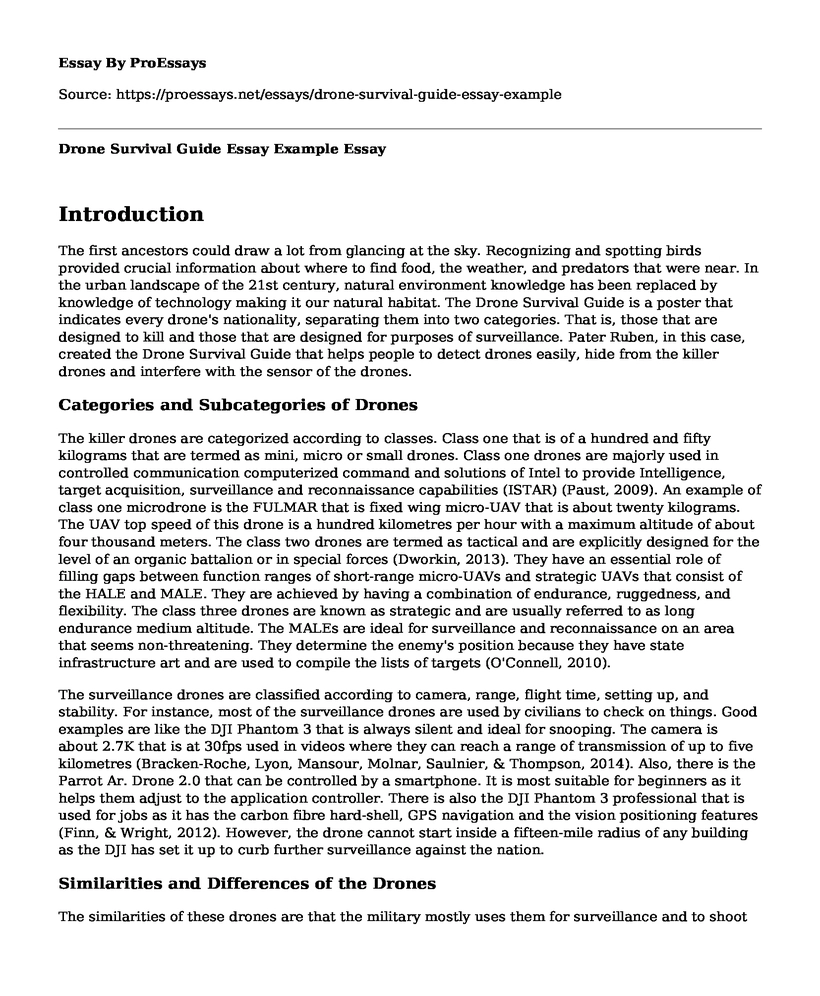Introduction
The first ancestors could draw a lot from glancing at the sky. Recognizing and spotting birds provided crucial information about where to find food, the weather, and predators that were near. In the urban landscape of the 21st century, natural environment knowledge has been replaced by knowledge of technology making it our natural habitat. The Drone Survival Guide is a poster that indicates every drone's nationality, separating them into two categories. That is, those that are designed to kill and those that are designed for purposes of surveillance. Pater Ruben, in this case, created the Drone Survival Guide that helps people to detect drones easily, hide from the killer drones and interfere with the sensor of the drones.
Categories and Subcategories of Drones
The killer drones are categorized according to classes. Class one that is of a hundred and fifty kilograms that are termed as mini, micro or small drones. Class one drones are majorly used in controlled communication computerized command and solutions of Intel to provide Intelligence, target acquisition, surveillance and reconnaissance capabilities (ISTAR) (Paust, 2009). An example of class one microdrone is the FULMAR that is fixed wing micro-UAV that is about twenty kilograms. The UAV top speed of this drone is a hundred kilometres per hour with a maximum altitude of about four thousand meters. The class two drones are termed as tactical and are explicitly designed for the level of an organic battalion or in special forces (Dworkin, 2013). They have an essential role of filling gaps between function ranges of short-range micro-UAVs and strategic UAVs that consist of the HALE and MALE. They are achieved by having a combination of endurance, ruggedness, and flexibility. The class three drones are known as strategic and are usually referred to as long endurance medium altitude. The MALEs are ideal for surveillance and reconnaissance on an area that seems non-threatening. They determine the enemy's position because they have state infrastructure art and are used to compile the lists of targets (O'Connell, 2010).
The surveillance drones are classified according to camera, range, flight time, setting up, and stability. For instance, most of the surveillance drones are used by civilians to check on things. Good examples are like the DJI Phantom 3 that is always silent and ideal for snooping. The camera is about 2.7K that is at 30fps used in videos where they can reach a range of transmission of up to five kilometres (Bracken-Roche, Lyon, Mansour, Molnar, Saulnier, & Thompson, 2014). Also, there is the Parrot Ar. Drone 2.0 that can be controlled by a smartphone. It is most suitable for beginners as it helps them adjust to the application controller. There is also the DJI Phantom 3 professional that is used for jobs as it has the carbon fibre hard-shell, GPS navigation and the vision positioning features (Finn, & Wright, 2012). However, the drone cannot start inside a fifteen-mile radius of any building as the DJI has set it up to curb further surveillance against the nation.
Similarities and Differences of the Drones
The similarities of these drones are that the military mostly uses them for surveillance and to shoot missiles at the combat of their enemies for example in states such as Pakistan and Afghanistan. Also, most of them are automatically driven by computers to aim at their targets. However, they differ such that those used for surveillance are cheaper than those used in killing due to the devices enacted in them (Wall, & Monahan, 2011). Also, the ones used in surveillance can be used by civilians to know certain things or places or even for business purposes, but the ones used in the killing are only used by the military to defend their nation. Also, most drones are designed for launching missions as they are attached to large spacecraft while the surveillance drones have UAVs that are tethered by the control link of the radio (Finn, & Wright, 2012). Thus, giving the two different names by the militia as Unmanned Aerial Vehicle (UAV) and Unmanned Aircraft Systems (UAS) for killing and surveillance drones respectively.
References
Bracken-Roche, C., Lyon, D., Mansour, M. J., Molnar, A., Saulnier, A., & Thompson, S. (2014). Surveillance drones: Privacy implications of the spread of unmanned aerial vehicles (UAVs) in Canada.
Dworkin, A. (2013). Drones and targeted killing: Defining a European position. European Council on Foreign Relations (ECFR).
Finn, R. L., & Wright, D. (2012). Unmanned aircraft systems: Surveillance, ethics and privacy in civil applications. Computer Law & Security Review, 28(2), 184-194.
O'Connell, M. E. (2010). Unlawful killing with combat drones: a case study of Pakistan, 2004-2009.
Paust, J. (2009). Self-defense targetings of non-state actors and permissibility of US use of drones in Pakistan.
Wall, T., & Monahan, T. (2011). Surveillance and violence from afar: The politics of drones and liminal security-scapes. Theoretical Criminology, 15(3), 239-254.
Cite this page
Drone Survival Guide Essay Example. (2022, Sep 04). Retrieved from https://proessays.net/essays/drone-survival-guide-essay-example
If you are the original author of this essay and no longer wish to have it published on the ProEssays website, please click below to request its removal:
- Virtualization of the City of Seabreeze
- Research Paper on Automation Impact on OSHA Compliance
- Essay Sample on AI-Powered Public Administration: Disaster Prevention in the 21st Century
- IoT: 24B Connected Devices in 1 Year, Smart Cities & Homes - Essay Sample
- Essay Example on Facial Recognition: Verifying Identity with Biometric Data
- Paper Example on Huawei's Innovative Health & Fitness App: A Comprehensive Review
- Technological Innovations in Manufacturing - Free Essay Example







